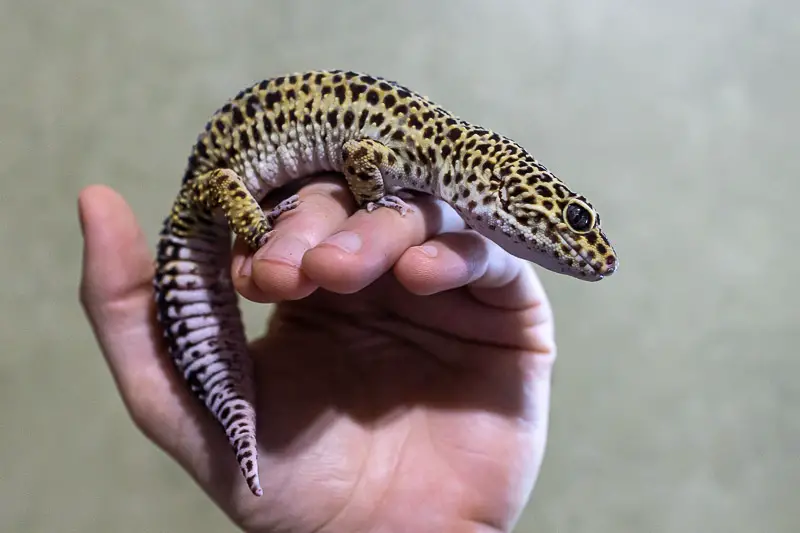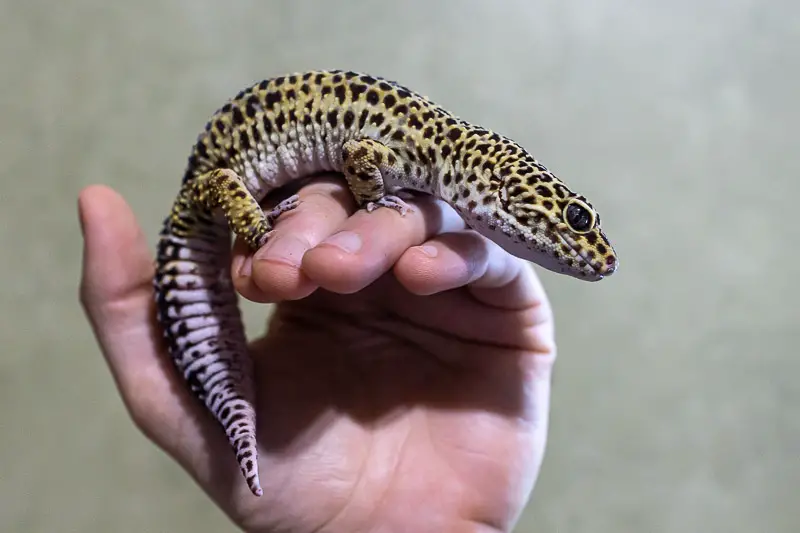Leopard geckos are one of the most popular pet reptiles in the world due to their docile nature and low maintenance requirements. However, handling them can be tricky, especially for first-time owners.
In this article, we will share five leopard gecko handling tips that will help you bond with your pet, reduce stress and ensure their safety. Read on to learn how to handle your leopard gecko like a pro!
Handling leopard geckos can be a fun and rewarding experience, but it’s important to follow some tips to ensure their safety and comfort. Firstly, wash your hands before handling them to avoid transmitting bacteria or oils. Secondly, approach them slowly and gently to avoid startling them. Thirdly, support their entire body, including their tail, when picking them up. Fourthly, don’t squeeze or restrain them too tightly. Finally, keep handling sessions short and infrequent to avoid stressing them out.

5 Leopard Gecko Handling Tips: A Guide for Beginners
Leopard geckos are one of the most popular reptiles kept as pets. These small lizards are easy to care for and have a calm temperament. However, handling a leopard gecko can be daunting for beginners. In this article, we will provide you with five leopard gecko handling tips to make the experience as stress-free as possible.
1. Approach Your Gecko Slowly and Gently
Approaching your leopard gecko slowly and gently is essential to its well-being and comfort. Sudden movements or loud noises can scare your gecko, causing it to become stressed and potentially aggressive. To avoid this, approach your gecko slowly and calmly. Place your hand in front of it and allow it to approach you. This helps your gecko feel more comfortable and relaxed.
It’s also important to handle your gecko gently. Never grab or squeeze your gecko, as this can cause injury. Instead, use a firm but gentle grip to pick up your gecko. Support its body and legs to avoid any accidental falls.
2. Wash Your Hands Before Handling Your Gecko
Washing your hands before handling your gecko is crucial to its health and well-being. Geckos are susceptible to illness, and any bacteria or germs on your hands can be harmful to them. Before handling your gecko, always wash your hands thoroughly with soap and warm water. This helps prevent the spread of harmful bacteria and keeps your gecko healthy.
3. Handle Your Gecko Regularly
Handling your leopard gecko regularly is essential to its socialization and well-being. Regular handling helps your gecko become more comfortable around humans and reduces stress. However, it’s important to start slow and gradually increase handling time.
Begin by handling your gecko for a few minutes each day, gradually increasing the time as your gecko becomes more comfortable. This helps your gecko feel safe and secure, leading to a happier and healthier pet.
4. Know When Not to Handle Your Gecko
While handling your leopard gecko is essential to its socialization, there are times when you should avoid handling it. During shedding, your gecko’s skin is sensitive and can be easily damaged. Avoid handling your gecko during this time to prevent injury.
Additionally, if your gecko is sick or stressed, avoid handling it until it has recovered. Handling a sick or stressed gecko can exacerbate its condition and cause further harm.
5. Provide a Safe Environment for Your Gecko
Providing a safe environment for your leopard gecko is crucial to its health and well-being. A secure and comfortable habitat reduces stress and promotes healthy behavior. Ensure your gecko’s enclosure is spacious enough for it to move around freely and has the appropriate temperature and humidity levels.
Additionally, provide your gecko with hiding spots and climbing structures to promote healthy behavior and reduce stress. This helps your gecko feel safe and secure, leading to a happier and healthier pet.
Benefits of Handling Your Leopard Gecko
Handling your leopard gecko has several benefits. Regular handling helps your gecko become more comfortable around humans, reducing stress and promoting healthy behavior. Additionally, handling your gecko regularly helps you bond with your pet, leading to a happier and healthier relationship.
Handling Your Leopard Gecko vs. Other Reptiles
Compared to other reptiles, leopard geckos are relatively easy to handle. Their calm temperament and small size make them an ideal pet for beginners. Additionally, their low maintenance requirements make them a popular choice among reptile enthusiasts.
In conclusion, handling your leopard gecko can be a rewarding experience for both you and your pet. By following these five leopard gecko handling tips, you can ensure a stress-free and enjoyable experience for both you and your gecko.
Frequently Asked Questions
Leopard geckos are a popular pet choice for many reptile enthusiasts. Proper handling is essential to ensure their well-being and happiness. Here are some common questions regarding 5 leopard gecko handling tips.
What is the best way to hold a leopard gecko?
The best way to hold a leopard gecko is by scooping them up gently from underneath, supporting their entire body with your hands. Avoid grabbing them by the tail, as it can break off and cause injury. It’s also important to be gentle and avoid squeezing them too tightly. Hold them close to your body and make sure they feel secure in your hands.
Additionally, it’s important to wash your hands before and after handling your leopard gecko to prevent the spread of bacteria or disease.
How often should I handle my leopard gecko?
Handling your leopard gecko is an important part of building a bond with them. However, it’s important to avoid overhandling them, as it can cause stress and lead to health problems. A good rule of thumb is to handle your leopard gecko for about 10-15 minutes a few times a week. This will allow them to get used to being handled without causing too much stress.
It’s also important to pay attention to your leopard gecko’s behavior and body language. If they seem agitated or stressed, it’s best to give them some space and try again later.
Can I hold my leopard gecko if they are shedding?
It’s best to avoid handling your leopard gecko while they are shedding, as their skin can be very sensitive during this time. Shedding can also cause them to feel more stressed or uncomfortable than usual. Wait until they have finished shedding before handling them again.
If you must handle your leopard gecko during shedding, be very gentle and avoid touching their skin directly. It’s also important to make sure their enclosure is properly humidified to help them shed more easily.
How can I make my leopard gecko feel comfortable while being handled?
Leopard geckos are prey animals by nature, so it’s important to make them feel secure and comfortable while being handled. One way to do this is to hold them close to your body, as this will make them feel more secure and less exposed.
It’s also important to avoid sudden movements or loud noises, as these can startle and stress out your leopard gecko. Move slowly and speak in a calm, soothing voice to help them feel at ease.
What should I do if my leopard gecko bites me while being handled?
While leopard geckos are not aggressive by nature, they may bite if they feel threatened or stressed. If your leopard gecko bites you while being handled, it’s important to remain calm and avoid jerking your hand away, as this can cause the bite to become more severe.
Gently remove your hand from their enclosure and wash the bite with soap and water. If the bite is severe or becomes infected, seek medical attention right away.
In conclusion, leopard geckos are fascinating pets that require proper handling techniques to ensure their safety and well-being. By following the five tips outlined in this article, you can establish a strong bond with your gecko and make handling sessions a positive experience for both you and your pet.
Remember to always approach your gecko calmly and gently, and to provide a comfortable and secure environment for handling. Take the time to get to know your pet’s personality and preferences, and adjust your handling techniques accordingly.
With patience, consistency, and a little bit of practice, you’ll soon be an expert in leopard gecko handling and be able to enjoy the company of your pet for many years to come. So go ahead and try out these tips, and watch as your bond with your gecko grows stronger with each passing day.

